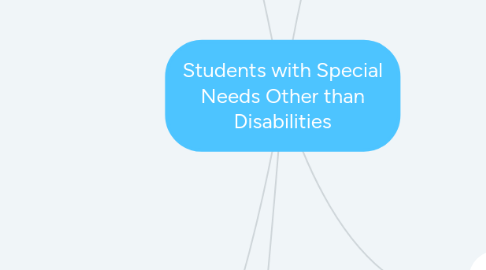
1. Needs of Students Who are Gifted and Talented
1.1. Students who cannot meet typical curricular expectations, have extraordinary abilities and skills
1.2. Nine intelligences
1.2.1. Verbal/llingustics
1.2.2. Visual/spatial
1.2.3. Logical/mathematical
1.2.4. Bodily/kinesthetic
1.2.5. Musical
1.2.6. Intrapersonal
1.2.7. Interpersonal
1.2.8. Naturalist
1.2.9. Existentialist
1.3. Characteristics
1.3.1. Intellectual abilities and academic skills
1.3.1.1. Extraordinary knowledge, insatiable curiosity, keen memory, advanced comprehension
1.3.2. Social and emotional needs
1.3.2.1. Range
1.3.2.1.1. Emotionally healthy to emotionally at risk
1.3.2.2. Unusual sensitivity to others' feelings
1.3.2.3. Set high expectation for themselves
1.3.3. Behavior patterns
1.3.3.1. Range of behaviors
1.4. Interventions
1.4.1. Curriculum compacting
1.4.1.1. Omit instruction on goals already met
1.4.2. Acceleration
1.4.2.1. Skip a grade
1.4.3. Enrichment
1.4.3.1. Extend learning with alternative assignments
1.4.4. Differentiation
1.4.4.1. Complete more challenging tasks over classroom material
1.4.5. Specialized interventions
1.4.5.1. Work with mentors, utilize technology
2. Needs of Students from Culturally Diverse Backgrounds
2.1. Minority Groups
2.1.1. 50.5% in U.S public schools
2.1.1.1. 9.4% English learners (77% Spanish speakers)
2.2. Dropout rates
2.2.1. Black 7.2%, Am Indian 13.2%, Hispanic 9.9%
2.2.1.1. Need role models in schools and effective teaching practices
2.3. Diversity and special education
2.3.1. Reduce bias with RtI, MTSS, and systematic decision making
2.4. Cultural Proficiency
2.4.1. Develop understanding; learn cultural norms affectiog bheaviors
2.4.2. Cultural factors and student behavior
2.4.2.1. Not differences in cultural values such as relationship
2.4.3. Informed instructional decision making
2.4.3.1. match needs of diverse students to instructional approaches -- equity pedagogy
2.4.4. Cross-cultural communication
2.4.4.1. Critical for EL students
2.4.4.1.1. Problems for students
2.4.4.1.2. Problems for teachers
2.4.5. 6 Levels of Language Proficiency
2.4.5.1. Entering
2.4.5.1.1. Word, phrases, one-step commands or directions
2.4.5.2. Beginning
2.4.5.2.1. Phrases and short sentences
2.4.5.3. Developing
2.4.5.3.1. Expanded sentences; some content language
2.4.5.4. Expanding
2.4.5.4.1. Some technical language of content areas
2.4.5.5. Bridging
2.4.5.5.1. technical language of content areas; oral/written language approaching English-proficiency
2.4.5.6. Reaching
2.4.5.6.1. Oral/written communication comparable to English-speaking peers
2.4.6. Families and Diversity
2.4.6.1. Strategies for building positive working relationships with parents
2.4.6.1.1. Believe all families are significant to their child's education
2.4.6.1.2. Examine your own beliefs and biases
2.4.6.1.3. Analyze your interactions with students/families from their perspectives
2.4.6.1.4. Visit students' neighborhoods, learn about their experiences
2.4.6.1.5. Invite parents' questions about school/education
2.4.7. Multicultural and Bilingual Education
2.4.7.1. Multicultural education
2.4.7.1.1. curriculum and instruction that reflect diversity of society; diverse cultures are valued
2.4.7.2. Bilingual education
2.4.7.2.1. Support English learners
2.4.7.3. English as second language (ESL) programs
2.4.7.3.1. Receive instruction primarily in English; no attempt to preserve native language
3. Needs of Students Who are at Risk
3.1. Students who have been exposed to some condition or situation that negatively affects their learning.
3.1.1. Prenatal drugs exposure, drug user, homeless, neglected, bullies, victims of bullies, suicidal, obsessed, unattractive, others
3.2. 3 Reasons to consider their special needs
3.2.1. Strategies for students with disabilities also help students at risk
3.2.2. Early intervention establish patterns of success
3.3. Characteristics
3.3.1. Poverty
3.3.2. Abused or neglected
3.3.3. Teachers
3.3.3.1. ethical obligation to report suspected abuse
3.4. Interventions
3.4.1. Set high, realistic expectations
3.4.2. Establish peers as teaching partners
3.4.3. Collaborate with other professionals
3.4.4. Support family and community involvement
4. Characteristics and Instructional Needs of Students Protected by Section 504
4.1. Understanding Section 504
4.1.1. Students with a wide range of needs that do not fall within the 13 federal disability categories for education are eligible for assistance through Section 504
4.2. Eligibility
4.2.1. Medical or health needs
4.2.2. Learning problems
4.2.3. Attention deficit-hyperactivity disorder (ADHD)
4.3. Accommodations
4.3.1. Presentation of instructions
4.3.2. Student responses
4.3.3. Environment/setting
4.3.4. Time and scheduling
4.3.5. Organization
4.3.6. Student Products
5. Accommodation for Students with Attention Deficit-Hyperactivity Disorder
5.1. Attention Deficit-Hyperactivity Disorder (ADHA): when a individual has chronic and serious inattentiveness, hyper-activity, and/or impulsivity that is more severe
5.2. 3 Categories of ADHD
5.2.1. Predominantly inattentive
5.2.1.1. Unfocused, appear to daydream
5.2.2. Predominantly hyperactive-impulsive
5.2.2.1. move a lot, blurt out
5.2.3. Combined type
5.2.3.1. Problems with both focus and movement
5.3. Characteristics
5.3.1. Normal intellect, but inability to regulate attention
5.3.2. Failure to execute functions
5.3.2.1. Working memory
5.3.2.2. Self-directed speech
5.3.2.3. Control of emotions and motivations
5.3.2.4. Reconstitution
5.3.3. Academic difficulties
5.3.4. At risk socially and emotionally
5.3.5. Behavior problems
5.4. Interventions
5.4.1. Behavior
5.4.1.1. Structure and rewards
5.4.2. Parent education
5.4.2.1. Strategies to respond to behavior
5.4.3. Medication
5.4.3.1. Stimulands, antidepressants
5.4.4. Academic
5.4.4.1. Short readings, extended time
5.4.5. Emotional supports
5.4.5.1. Minimal distractions, rules/routines
5.5. Strategies for Teaching Students with ADHD
5.5.1. Introducing lessons
5.5.1.1. Advance organizers, review of prior lesson
5.5.2. Conducting lessons
5.5.2.1. Predictable structure, participation support, help to focus
5.5.3. Concluding lessons
5.5.3.1. Preview of next lesson, assignment completion checkup
